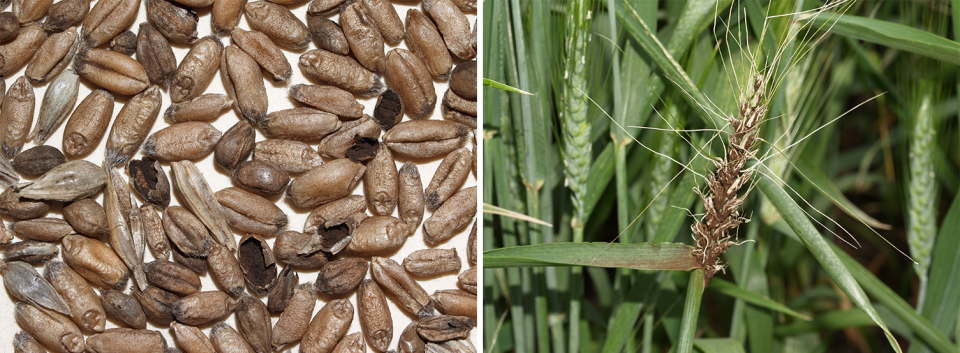
The Importance of Certified, Fungicide-Treated Wheat Seed
This year there was at least one report of a wheat field with common bunt, also known as stinking smut in Nebraska. Stinking smut derives its name from a strong fishy odor associated with infected wheat kernels called bunt balls (Figure 1). It is caused by two closely related fungi whose spores contaminate grain during harvest. When contaminated grain is used as seed and cool moist conditions prevail in the soil, the spores germinate into mycelia (strands of hyphae of a fungus) shortly after planting. The mycelia infect coleoptiles before seedling emergence, grow within the developing wheat plant, and eventually inhabit the flower primordia (earliest stage of flower development) of the head.
In susceptible varieties, the mycelia replace ovary tissues and produce black spores called teliospores which fill up the seeds, resulting in bunt balls that are dull gray-brown in color with a fragile cover. During harvest the bunt balls rupture, releasing the black teliospores that contaminate seed as well as the soil. In severely affected wheat fields, dark spore clouds can be seen during harvest.
Stinking smut is one of several fungal diseases of wheat that result from contaminated or infected seed. Other diseases include loose smut (Figure 2), ergot (Figure 3), root and seedling diseases resulting from Fusarium-infected wheat seed (Figure 4), and black point (Figure 5). Black chaff (Figure 6), a bacterial disease, is also seed transmitted.




Economic Importance of Seed-Transmitted Diseases
Seed-transmitted diseases reduce yield as well as grain quality. Grain contaminated by stinking smut can be rejected at the elevator, often resulting in total loss. The pungent odor associated with contaminated grain causes livestock to reject it, significantly reducing its value as a feed. In addition, the compound responsible for the odor, trymethylamine, can cause explosions in combines and elevators when present in appropriate concentrations.
Although loose smut does not affect grain quality, yield losses of up to 40% can result from the disease.
Incidence of ergot in wheat is relatively low. It can cause up to 10% yield loss. In 2011, ergot caused economic losses in south central and southeast Nebraska. Sclerotia or ergots (compact masses of the ergot fungus) can lower grain quality. In addition, the ergots contain toxic alkaloids that can cause ergotism and death in humans and livestock.
If seed that's heavily infected or contaminated with Fusarium is sown, for example seed from fields affected by Fusarium head blight, seedling emergence can be reduced by up to 80%.
Black point can significantly reduce the bread-making quality of wheat. Heavy contamination of grain with black point can result in discolored flour. This can cause discounts at the elevator or rejection by millers.
Black chaff can cause up to a 40% reduction in yield. If seed is severely infected by the black chaff bacterium, germination can be significantly reduced.
Managing Seed-Transmitted Diseases
Three strategies can be used in combination to manage seed-transmitted fungal diseases of wheat:
- fungicide seed treatments,
- use of clean seed, and
- planting resistant varieties.
Seed treatments are important for several reasons. They control seed-transmitted fungal pathogens that may be surface-borne on the seed or internally seed-borne. Additionally, they control soil-borne pathogens such as Fusarium, Pythium, and Rhizoctonia that cause seedling damping off and root and crown rots. Systemic seed treatments also provide additional protection against fall season foliar fungal diseases.
In addition to controlling diseases, fungicide-insecticide combination seed treatments also control insect pests such as wireworms, Hessian fly, and fall season aphids. By controlling seedling damping off, seed treatments improve stand establishment and result in healthy, vigorous seedlings. Such seedlings build natural defenses that provide additional protection from diseases and insect pests.
Cleaning Seed. It is preferable to buy certified treated seed or have it cleaned and commercially treated. If seed is treated on-farm, it is essential to clean it before treating. Cleaning seed before treating is especially necessary if the seed-transmitted diseases listed above were present in the field during the growing season. For the seed treatment to be effective, ensure thorough, uniform coverage. If possible, use a broad-spectrum systemic fungicide or fungicide-insecticide combination product.
For a list of seed treatment fungicides for control of seed-transmitted diseases of wheat, see Table I.
Fungicide seed treatments are not effective against ergot and black chaff. The best strategy for managing these diseases is using certified, pathogen-free seed.
For more information on diseases affecting grain and seed quality in wheat, see Distinguishing Between Head Disorders of Wheat (EC1872).
Resistant wheat varieties, where available, can be used in combination with seed cleaning and seed treatments to more effectively manage seed-transmitted diseases of wheat.
Importance of Using Clean, Certified, Fungicide-Treated Seed
The importance of using clean, certified, fungicide-treated seed cannot be overemphasized and will optimize the chances of obtaining high yields. Using farmer-saved or bin-run seed is likely to result in
- poor variety purity,
- a low germination percentage,
- poor stand establishment,
- inceasing weed problems (due to weed seed), and
- disease and insect problems.
The result will be reduced yield and poor grain quality. Total loss may result if grain is heavily contaminated with fungal spores such as those of the common bunt fungi. Additional costs may be incurred in treating for diseases, insects, and weeds resulting from use of poor quality seed.
In terms of dollars, the return from using clean, certified, treated seed will almost always exceed the cost of the seed. It's a form of insurance that is definitely worth the cost.
Online Master of Science in Agronomy
With a focus on industry applications and research, the online program is designed with maximum flexibility for today's working professionals.
